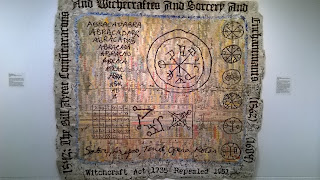 |
| 'Certaine Wytches.' Tapestry by Anne Jackson |
The technique of knotting tapestries is, as the artist points out, ‘hugely time consuming’, but in itself symbolises the witches who used ‘knot magic’ for charms and to raise storms, for which they were condemned to die by means of the knotted hangman’s noose, as is starkly illustrated in the first tapestry – Certaine Wytches.
‘Certaine Wytches, Chelmsford, Essex’ is a memorial to three witches from the same family who were tried at Chelmsford in 1566, Joan Waterhouse, her mother, Agnes and her grandmother, Eve. Agnes was hanged and the title of the tapestry comes from a trial pamphlet of the time.
 |
'Grace Thomas and Temperance Lloyd:
Why dost thou weep for me?''
Tapestry by Anne Jackson
|
 |
'The Devon Witches: Half Hidden Signs'
Tapestry by Anne Jackson
|
'their acts of magic are silent and unseeable, detectable only by half hidden signs.'The artist has included images in the tapestry still used in pagan ritual today, including some runes which were given to her by a practising witch in her village,
In 'Once upon a Time.' Anne Jackson explores the way children are introduced to the concept of the ugly and wicked witch through bedtime fairy tales, whose caricature images feed into Halloween costumes and decorations. We are all familiar with the Disney cartoon of 'Snow White' being given the poisoned apple by the wicked witch, her stepmother, but tragically, this accusation is not a fairy tale. In 1664, Elizabeth Style at her trial in the cider town of Taunton was accused of poisoning a child by giving her a ‘very fair red apple’. Anne Jackson points out that cutting an apple in half is used in love charms. It has been also been used for centuries by many ordinary girls at Halloween to divine when they will be wed. Thinking of bedtime stories, reminded me that the wicked witch or bad fairy in 'Sleeping Beauty' lures the princess to pick her finger as she spins flax into thread, another link between witchcraft, spinning and weaving that has burrowed deep into our collective psyche.
 |
'Once Upon a Time' and 'Never mention Money'
Tapestries by Anne Jackson
|
The tapestry exhibition is supported by a number of fascinating witchcraft artefacts on loan from The Museum of Witchcraft in Boscastle, Cornwall, including a pair of glass knitting needles used to create curses and charms. The piece of knitting made in the course of the casting the spell would later be burned, so that the spell was fixed and could not be unravelled.
 |
| Tapestry by Anne Jackson |
‘Certaine Wytches’ is currently on until 6th May 2019, at Devon Guild of Craftsmen, Riverside Mill, Bovey Tracey, Devon TQ13 9AF (Funding by Devon Guild of Craftsmen, Arts Council of England and Heritage Lottery Fund.)

No comments:
Post a Comment